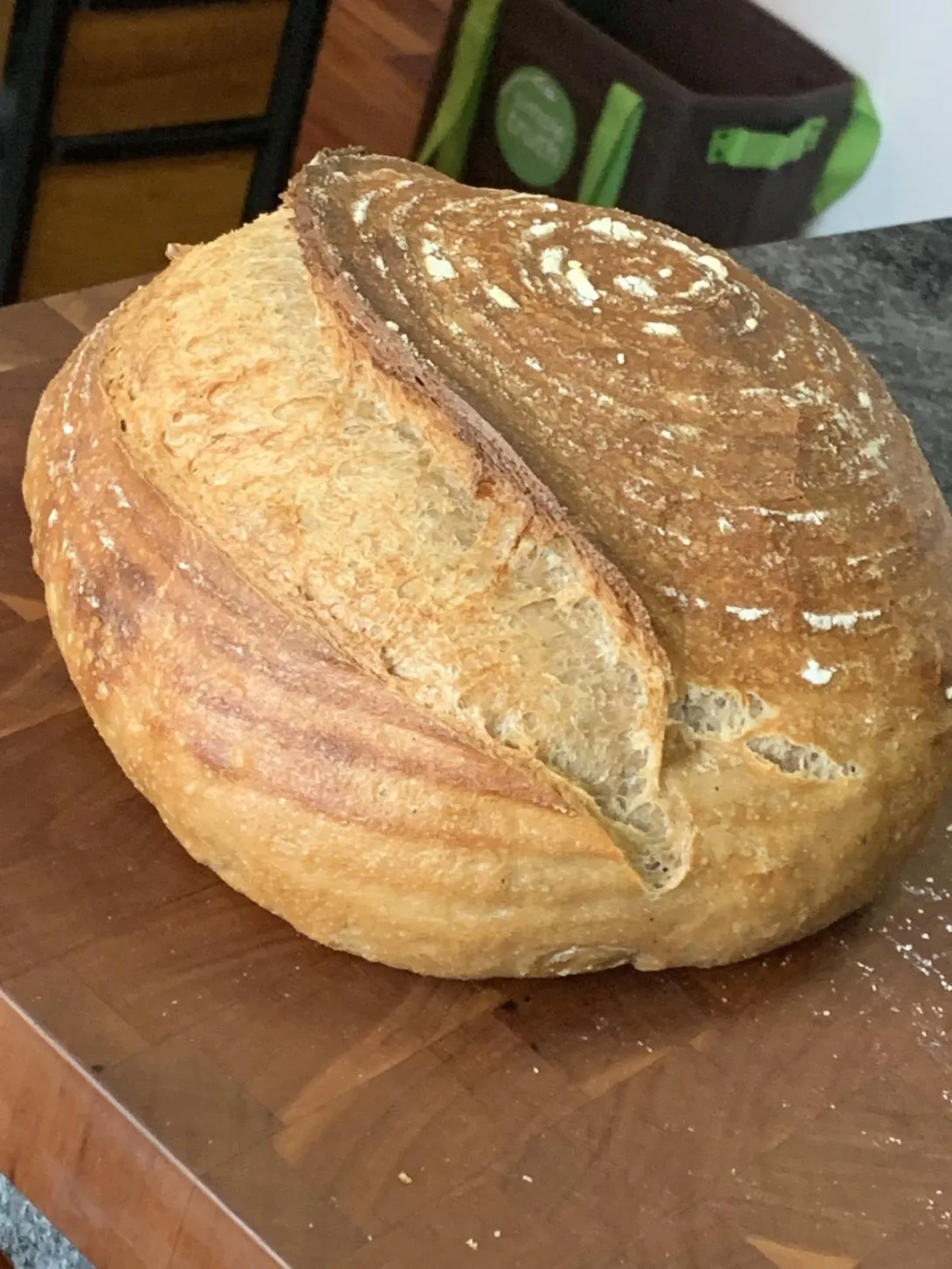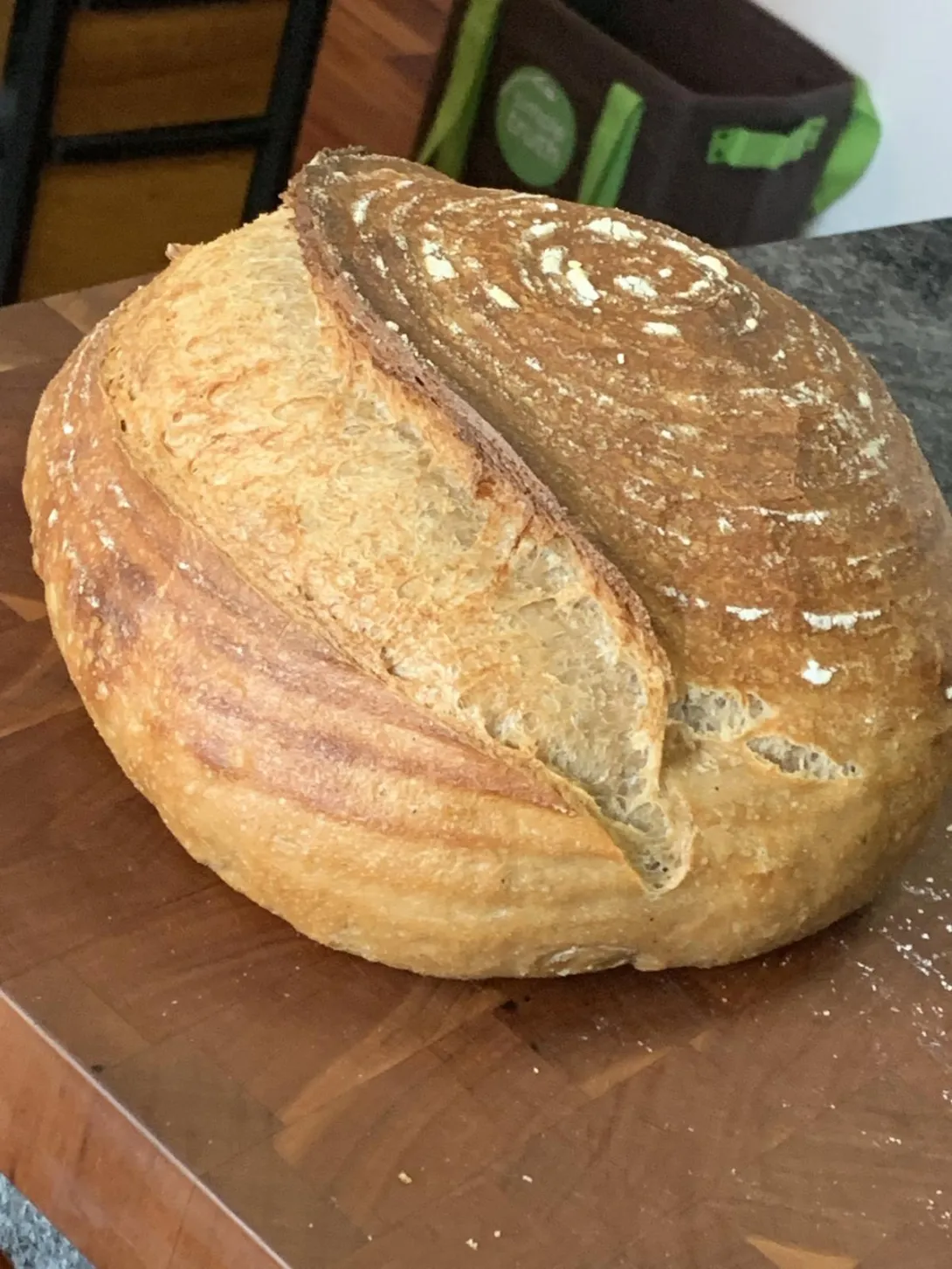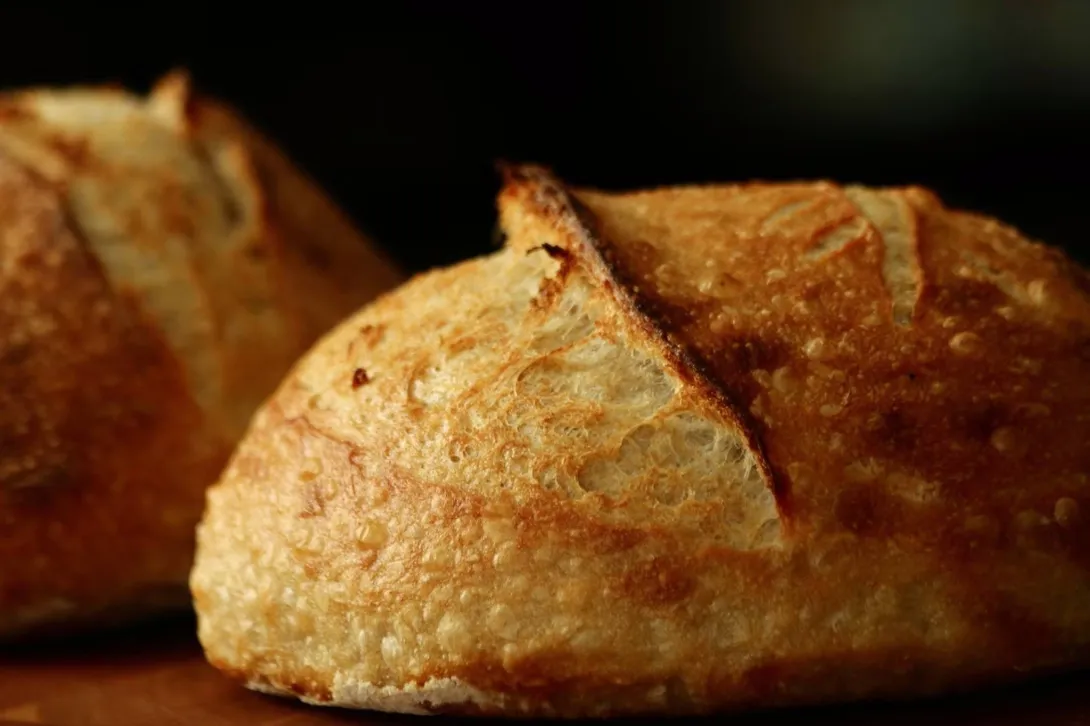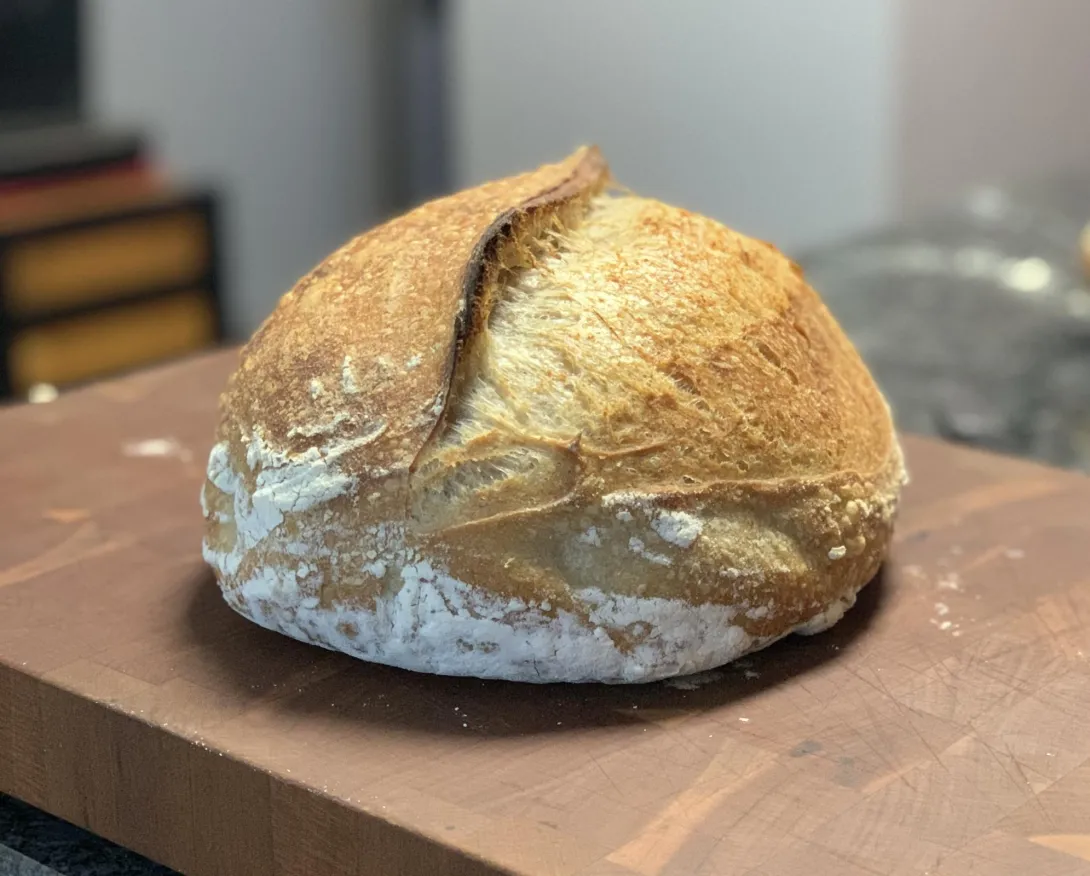
I've been making sourdough for years but rarely ever get that explosive oven spring where the outer layer peels all the way back as that basketball-size inner dough expands. My loaves have a gentle smile but not that head-back, full-throated laugh you see in many great loaves.
I feel like I have tried everything and followed well-respected "recipes" and method fastidiously, to no avail. My regular recipe -- and one very typical to most others -- is 75-80-% strong white flour, 20-25% whole wheat, 60-75% hydration, and 2% salt.
Methods (I'll show the range of methods tried just so anyone still reading at this point can appreciate that I've tried it:
1 Starter. Robust, usually fed twice. 2-3X expansion and used at peak.
2. Temperature. I am exacting about watching temperature at every stage. Typically a target of 80F.
3. Autolyse. I typically autolyse for an hour, sometimes a bit loss, sometimes as long as 3-4 hours. I have also done the method you often see where you dissolve the starter first in water and then add the flour.
4. Gluten development. I have done it where you work the flour first for a while, other times just 3-4 coil or stretch-and-folds over the first 1.5 hours or so.
5. Bulk fermentation. I typically shoot for a 40-50% rise. I've gone every from 2.5 - 4.5 hours just to experiment, but typically land at about 4 hours. Bubbles showing on top and on the sides, and light, "jiggly"feel. Domes on top.
6. Preshape with typical methods, and final shaping. after 30 minutes. I am curious whether I might be building too much surface tension... I've seen videos where the baker does one, easy final shaping and off to the banneton, others where they really work the dough on the counter to build a tight surface.
7. Overnight in a 38F fridge for 12 hours.
8. I score at a very shallow angle (closer to parallel to the table surface.)
9. I've tired every oven method there is -- preheated with the bread cast iron pot, hot oven/cold pot, cold oven/cold pot. Start at 475-500, reduce to 450-425 after 20 minutes, all that. I've even added an ice cube or two to the hot pot version to enhance steam.
Even though I've showed quite a range of methods here, I do not jump around as much as it seems, nor do I mix methods. I tend to work one method several times to make sure I'm following it and adjusting as needed.
The results -- good crumb, great crust, great taste, but just a flaccid rise. Sometimes a good ear, sometimes not, but almost always the outer layer does not peel back much at all, with the inner dough only representing 20% or so of the final surface.
I have seen people follow all the rules and seemingly break most of the rules and still come out with great oven spring and nicely textured loaves. I'm at a loss.
I'm open to ideas from this expert group!
I feel for ya.
But you're still leaving out some pertinent info. Your crust surface hints at something that I can't quite identify and need more facts... about either the ingredients or the oven.
Most cases of "long term frustration" where the baker says "i've tried _everything_ and just can't get it right", the answer is usually in something that they did not consider a factor.
In baking, everything matters: the flour, the water, the oven, and how the oven is used.
Therefore, I'm going to ask questions about things you did not mention.
What exact brands/types of flour? Links? Specifications?
What kind of banneton, Lined or unlined, and with what? Dusted or not? Dusted with what? (I'm keying in on your crust surface, and the banneton/liner plays a part there.)
What kind of water? Bottled spring, or bottled purified? Private well or municipal? Where are you located (city/state)? Is there a water softener in the house? If using municipal water, where do they get the water, river, reservoir, or wells?
Please describe the oven. Gas or electric? Convection? If electric, Which elements (bottom/top/backside) are used, and when? Convection and/or top heat (improperly used) play a big factor in oven spring.
Also, some crumb photos may help, so people can see a cross section of the crust layer. That sometimes gives clues.
I may not be able to find the exact answer, but hopefully there might be someone else who can recognize the key clue in your answers and zero in on it.
Dave,
Thanks for such a thoughtful reply. Yes, there is always "something" more, so I'll address your questions and see if we can spot something
What exact brands/types of flour? Links? Specifications?
Most often Central Milling Organic Baker's Craft (11.5% protein) and a fresh milled whole wheat flour through Breadtopia. In a pinch, I've resorted to King Arthur bread fliour. Sometimes 5% spelt or rye, not no difference when used.
What kind of banneton, Lined or unlined, and with what? Dusted or not? Dusted with what? (I'm keying in on your crust surface, and the banneton/liner plays a part there.)
Regular cane-style banneton. Have used both circular and oval. Unlined but well-coated with rice flour each time. My crusts generally are nice and crackling.
What kind of water? Bottled spring, or bottled purified? Private well or municipal? Where are you located (city/state)? Is there a water softener in the house? If using municipal water, where do they get the water, river, reservoir, or wells?
Municipal water, not sure of source but run through advanced filter such as Bria. No water softener. I often leave the water out on counter for several hours to dissipate any chlorine=. I don't trust bottle water to not have chlorine, since most of it misleadingly is just muni water anyway.
Please describe the oven. Gas or electric? Convection? If electric, Which elements (bottom/top/backside) are used, and when? Convection and/or top heat (improperly used) play a big factor in oven spring.
Currently electric but I had much the same problems with gas earlier. My current electric is low-budget oven, with one lower heating element. No, I have not checked actual temperature on this one but did on two others. Thought that 500F for 45 minutes would cover any shortcomings there, especially when I see people making great loaves with cold start or oven only at 450. Maybe something there, dunno....
Three basic elements of successful oven are:
1. Slightly under-fermenting.
2. Scoring.
3. Tight surface skin.
--
For 1., you might try using less starter/levain, or using a younger levain instead of a mature starter.
For 2, when baking boules, I seem to get a better oven spring with a # style score rather than a single long cut.
For 3, I take extra care to "scooch" or pull the dough across the work surface (counter top) in all directions, because pulling the surface tight develops that "gluten cloak" needed for good spring.
"Food Geek" has a couple good videos on shaping:
How to shape dough: www.youtube.com/watch?v=IxVSlizlt-s
More on shaping, why: www.youtube.com/watch?v=JvA6jJsr0HY
Using a lined and dusted banneton also helps to "wick away" moisture, and that drying effect makes a good "skin" on the dojgh.
Thanks for the additional thoughts...
For 1., you might try using less starter/levain, or using a younger levain instead of a mature starter.
I use 20% now with an average four-hour bulk ferment. I guess you suggest I back down to 10-15% and five- or six-hour bulk ferment? I want to make sure I understand the terms when you say "yoing" and "mature." By mature do you mean how many years old is the starter? If you mean at what stage is the starter in its own leavening, I tend to feed it twice before use, where it is at least doubling in volume. I also discard between each feeding to keep down the LABa and encourage the yeast.
For 2, when baking boules, I seem to get a better oven spring with a # style score rather than a single long cut.
I can certainly try that, although some of the ones I've seen that I most envy (!) are single score. I am still wondering if this is a lack of spring or that the crust is constraining it.
For 3, I take extra care to "scooch" or pull the dough across the work surface (counter top) in all directions, because pulling the surface tight develops that "gluten cloak" needed for good spring.
Yes, that's what I do. I pull in all directions, cupping my hands near the bottom of the dough and dragging it across an unfloured surface. All that said, I ahve seen some fantastic loaves where all they did not was an envelope fold and plopped it in the banneton, so I'm baffled about whether I am getting that outer skin right.
Yikes, I feel like I did not give you much to go on.
Dave has given you a lot to think about and discuss. Just from the one photo, which by the way isn’t enough to come to a lot of conclusions, I wonder how low in the oven you’re baking? The top of much darker than the sides so I wonder if you are baking low enough to get that oven spring you need? A cross sectional photo of the crumb would be very helpful, in it we would see the crumb structure to diagnose the fermentation but also we’d see if the bottom crust is dark enough to show good heat on the bottom.
Edited to add: The score you did on that loaf is really to the side of the dough, have to tried scoring down the midline of the dough for a more even bloom?
Benny
Benny,
You raise an interesting point. I have often avoided the lower rack because it result sin a very hard bottom crust that is hard to cut. I even put a stone or cookie sheet underneath to prevent that. I would have thought center rack would be right to get more even heat over the whole loaf.
Here is "a" picture of crumb, but I would ask that you not over-interpret this in that I was trying the "mix starter/water first" method and a totally cold start so I was guessing on time. Most of my loaves are notably darker than this. However this is a very typical crumb distribution for me.
Your crumb is excellent and I do not see any issues with fermentation there.
The crust is quite pale all around on this one.
I hear you regarding the bottom crust being very dark but we need good bottom heat at least during the first steamed part of baking. What I’d consider doing is baking low during steaming and if you’re finding that the bottom gets too dark, move your bread up to the middle of the oven after the steam portion is over and shield the bottom if you like.
But definitely try scoring more mid line if you want a bigger bloom, you’re way to far over to the side.
Will do. Thank you. I'll post the result.
This is more typical of my final results. I have an ear here, but also sometimes end up with a very flat score line.
Image

The incision is too much to the side on this loaf.I would recommend that you look at Benitos recent oven video to understand how the bloom is manifested. I would add that it is more difficult to get a bloom on a round loaf because the cut is not across the grain to release the tension like an oval. That is why the # works better for round loaves
D
Where can I find his video? Thanks.
https://www.thefreshloaf.com/node/70113/country-sourdough-egg
Great loaf in my humble opinion.
Are you baking in an enameled dutch oven, perchance?
Best wishes. Dave
Personally I am a little sceptical about some of the posts on various social media showing prize winning style loaves within weeks of starting sourdough baking. But maybe that’s just my sour grapes. I very very rarely achieve great rise and it’s more likely to happen in warmer weather.
No, all the ones I am referring to are by a wide range of experienced bakers, often using different techniques. I do get the "oven spring envy" part, though.
Dave & Benny,
Don't let it go to your head (!), but this morning's loaf was better. I did move the scoring line up (this was a batard). As I look closely, it looks like I could have scored more deeply. At least it looks a bit perkier with a good ear. I'm still not where I want to be, but better than what I've been getting. Temp was closer to 76F instead of my normal 80F. And, yes, I moved it to a lower rack in the oven for the steam portion of the bake. Bottom crust is great.
Interestingly, I did the method where you put some dough into a small, glass jar with a rubber band to mark its starting point so you can more precisely measure the rise during bulk fermentation. I stopped at about 40%. This morning the dough in that jar had tripled in height with no sign of collapsing. I would have to imagine that if I did something close to that for the whole loaf it would be badly over-proofed, but it had me wondering if I ought to push my bulk ferment a
Image

bit more -- 50-60% if there is that much more runway in the dough
That is an improvement for sure, but you could still move your scoring to midline and get the bloom to be more central.
The aliquot jar https://www.thefreshloaf.com/node/64897/aliquot-jar-determine-bulk-fermentation-rise which I link to there is very useful to more accurately gauge the degree of rise your dough is getting. The skill required for shaping increases the greater the rise in your dough at the end of bulk. So yes you could go to 60% rise but shaping will be more challenging and the degassing you’ll cause will have less time to recover from. I prefer to shape at 40-50% rise and then give some time with a warm final proof before cold retard or baking.